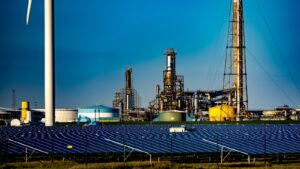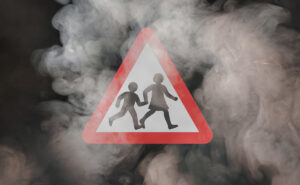Dominic Rohner, professor of Political and Institutional Economics at HEC Lausanne, University of Lausanne explains why wisely designed regulation and environmental and economic policy may allow countries to improve air quality, build back better and create a sustainable economy without making huge sacrifices to quality of life.
Air pollution causes several million deaths every year, disproportionately affecting the global poor.
Since it is directly related to economic activity, it is reasonable to assume that air quality is likely to improve if economic activity is restricted. In normal times, that hypothesis would be difficult to test. But these are not normal times.
The measures taken to try to deal with Covid-19 have therefore provided an unprecedented opportunity to study the environmental consequences of reduced human activity at a national and regional level.
But to get the full picture of how Covid-induced restrictions and lockdowns have impacted air pollution in the short- and medium-term demands a global study to measure the impacts across the entire globe.
We set out to fill this gap by undertaking the first study to analyse the impact of lockdowns spanning the period to the end of 2020.
So, the first key data source we needed was a detailed dataset of different lockdown measures covering 162 countries, for which we were able to draw on the data of Bonardi et al.
By distinguishing between the various types of measures – from school closures, curfews and partial lockdowns all the way through to national border closures – we hoped to be able to determine how the strictness of a policy impacted air quality.
We also extended the time horizon to include information on lockdown releases.
The second key element was pollution data.
While pollution monitoring networks exist worldwide, they only offer limited geographic coverage. We overcame this by using daily, high-resolution satellite-based pollutant retrievals from NASA. With these, we could measure high-resolution PM2.5 concentrations from nearly 12,000 cities in 176 countries.
But in order to ensure reliability, we also had to take into account a range of variables that can distort the accuracy of the data.
These include meteorological factors such as rainfall, humidity, temperature, wind speed and planetary boundary layer height, all of which have a bearing on pollution levels.
The sorts of measures put in place varied from country to country but can broadly be divided into inside measures (restrictions within a country) and outside measures (such as restricting or prohibiting people coming into a country by closing borders and/or imposing quarantine for arrivals). Both had major impacts.
Our headline finding is that the unprecedented reduction in mobility and human economic activity that accompanied the Covid pandemic led to dramatic improvements in air quality.
We found that air pollution in urban areas fell by a global average of 35-45% as a result of lockdown measures, and by much more in some countries.
More specifically, when we looked at a period of 120 days after measures were introduced, inside and outside lockdowns reduced PM2.5 concentrations by 45% and 35% respectively compared to the 60 days prior to their introduction.
Overall, we found that this pollution impact accumulates over time, showing the strongest reduction at 90-120 days into lockdown. But that’s not the case with closing airports and international borders, which led to marked improvements in air quality after less than 30 days. Where both inside and outside measures were combined – such as e.g. in Australia – the impact could be even more dramatic.
But how far did these improvements persist?
Did the loosening of lockdowns in many countries over the summer of 2020 reverse the environmental gains of the previous months or did they persist after economies started to reopen?
One possible explanation could be that flight travel has still not returned to pre-pandemic levels, and home working has remained very widespread even after some lockdown restrictions were lifted. This longer-term impact assessment is important because it allows us to evaluate the sustainability of particular policies for bringing the environment back on track in future.
While our headline pollution reduction figures are startling, they don’t tell the full story.
Interestingly, there is no global linear relationship between reduction in economic activity and pollution that is the same for every country. As might be expected, many countries saw reductions in air pollution accompanying substantial reductions in their GDP.
However, in some countries such as Brazil, India, Japan and South Korea, falls in GDP led to increases in pollution.
Some of these differences can be explained by different sources of air pollution.
While emissions from transport and industry play an important role in densely populated parts of Europe and North America, air pollution in Latin America and Asia is dominated by biomass burning, agriculture and residential energy use.
Hence, lockdown measures in these regions are likely to increase residential energy use (mainly for heating) even though they also reduce pollution from transportation, especially air transport and commuting.
Other anomalies come about as a result of political factors. For example, the US mid-West saw increases in pollution that may be due to a rollback in the enforcement of environmental regulations during the pandemic.
The significance of these findings in terms of environmental and economic policy is that they demonstrate that reducing economic activity or mobility does not necessarily help the environment to the same extent in every context.
Some countries even experienced a lose-lose situation during the pandemic, suffering both economic decline and an increase in air pollution.
This comes about because remaining economic activities was more harmful to the environment than what came before. For example, while discouraging commuting may improve air quality in one region, it can have the reverse effect in a region in which increasing decentralized economic activities is associated with elevated pollution levels related to space heating.
So improving air quality is a lot more complicated than simply restricting economic activity, something decision-makers need to have at the forefront of their minds as they turn their attention to how we are going to build back better. What works in one region may not work in another – there is no ’one size fits all’ approach.
The different variables which factor into policy decisions on this issue also underline the importance of market-based instruments such as taxing polluting activities or cap and trade systems, both of which would incentivise more environmentally-friendly behaviour and encourage innovation in less polluting technologies.
However, the fact that during the Covid-19 pandemic various countries (like e.g. Norway) have managed to significantly reduce pollution while keeping their economies afloat suggests that wisely designed regulation may allow countries to build back better.
To read the full study, click here.
Photo Credit – Pixabay

















Leave a Reply